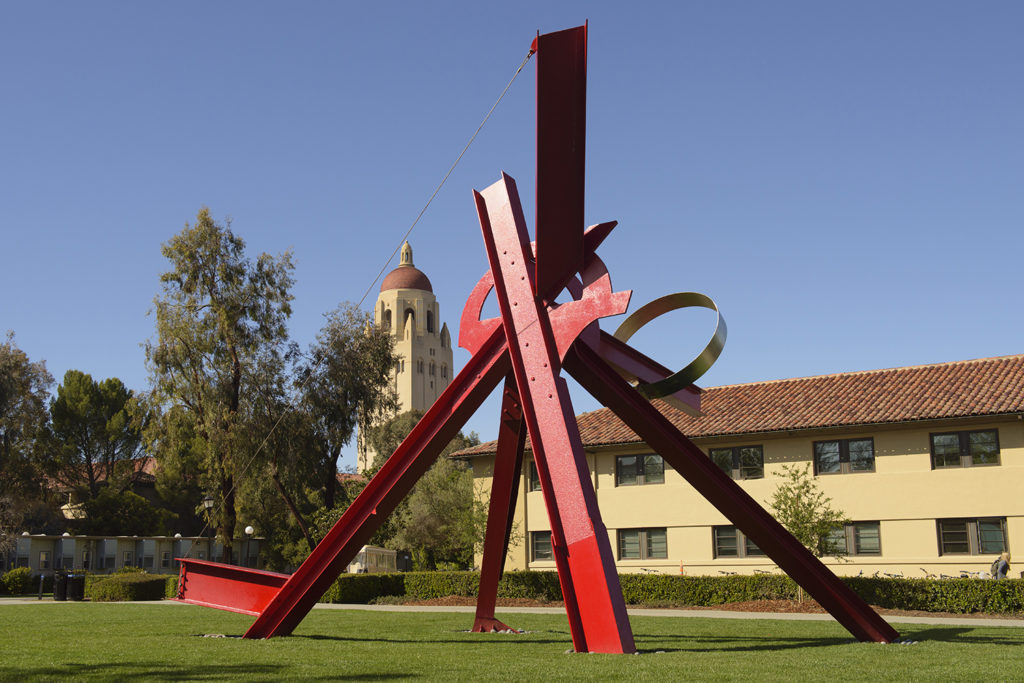Stanford launches search for the next vice president for the arts
A broad search committee of on- and off-campus constituencies expects to make its recommendation to the president by fall.
This month, Stanford launched the search for a new vice president for the arts with the goal of having the new leader in place by the beginning of the 2021-22 academic year. Reporting to the president, the vice president will represent the arts at the highest levels of the administration. They will champion the arts as fundamental to the Stanford experience and the university’s mission as well as develop strategies to support and amplify the work of the arts organizations that are housed under the auspices of the Office of the Vice President for the Arts (VPA).

The Sieve of Eratosthenes by Mark di Suvero (U.S.A., b. China, 1933), 1999. Stainless steel and paint. (Image credit: L.A. Cicero)
“We have made great strides in the arts on campus thanks to the Arts Initiative and incredible energy and enthusiasm from our community,” said Matthew Tiews, associate vice president for campus engagement and interim senior associate vice president for the arts, whose responsibility in his interim role includes making recommendations on how to best structure and support arts activities in the next phase of the VPA. “This is an amazing opportunity to bring in a leader who will take the arts to the next level, especially since our COVID experience has brought home to us the importance of the human connections and transcendent experiences that the arts can create.”
In the next phase of the VPA, opportunities include increasing the commitment to community engagement, social justice and culture change; focusing on the role of the arts in emotional and physical wellbeing, and connecting the arts to the purposeful nature of Stanford’s mission and Long-Range Vision.
The search committee for the vice president is co-chaired by Tiews and Srinija Srinivasan, trustee and member of the Stanford Live Advisory Council. They are joined by nine committee members representing key constituencies on and off-campus: Lanier Anderson, professor of philosophy and senior associate dean for humanities and arts, School of Humanities and Sciences; Janani Balasubramanian, alum, artist and researcher; Melissa Fetter, chair of the Cantor Arts Center Director’s Advisory Board; Lyndsey Kong, undergraduate and student community liaison for the VPA; Peggy Phelan, professor of English and of theater and performance studies, former director of Stanford Arts Institute; Steve Sano, professor of music and director of Chamber Chorale and Symphonic Chorus; Martin Shell, vice president and chief external relations officer; Vaughn Williams, former trustee and chair of the Stanford Arts Advisory Council, and Elizabeth Zacharias, vice president for human resources.
Working with the executive search firm Isaacson, Miller, the search committee will make a recommendation to President Marc Tessier-Lavigne, who will make the final decision.
One of the first responsibilities for the new vice president will be finalizing the search for the next director of the Cantor Arts Center. A separate committee for that search will launch soon and is expected to make recommendations to the newly appointed vice president in the fall.
The Office of the Vice President for the Arts was established in February 2017 to elevate the arts in the university’s priorities and lead strategic planning for the university’s arts goals. Harry Elam, president of Occidental College since 2020, was Stanford’s first vice president for the arts, a position he held while also serving as senior vice provost for education and vice provost for undergraduate education. The new senior hire will be the first full-time vice president for the arts.
The arts programs under the auspices of the VPA include the Anderson Collection at Stanford University, the Cantor Arts Center, the Institute for Diversity in the Arts, the Stanford Arts Institute and Stanford Live. The VPA also operates a central office, which provides operational support for all of the units mentioned above, and resources for students and faculty. The academic arts departments, including Music, Theater and Performance Studies, Art and Art History and the Creative Writing Program in the Department of English, are all housed in the School of Humanities and Sciences. The new vice president will work closely with the school and other campus partners to ensure that the arts are connected and integrated across the university.